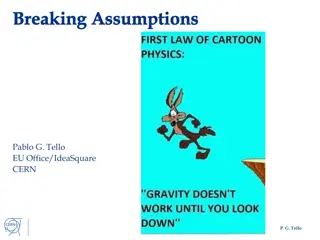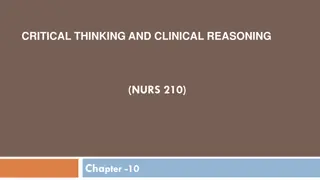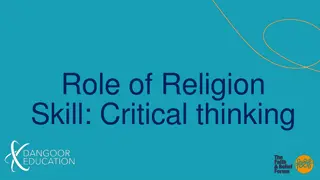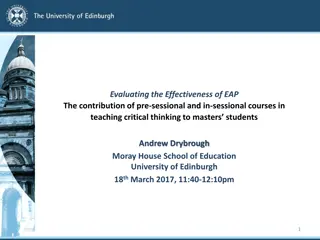Critical thinking
Analyze a specific policy related to unemployment benefits, critique key points, evaluate relevancy to policy analysis paper, and assess logical consistency. Examine evidence, discuss support or disagreement with other readings, and present a well-argued synthesis of ideas.
Download Presentation

Please find below an Image/Link to download the presentation.
The content on the website is provided AS IS for your information and personal use only. It may not be sold, licensed, or shared on other websites without obtaining consent from the author.If you encounter any issues during the download, it is possible that the publisher has removed the file from their server.
You are allowed to download the files provided on this website for personal or commercial use, subject to the condition that they are used lawfully. All files are the property of their respective owners.
The content on the website is provided AS IS for your information and personal use only. It may not be sold, licensed, or shared on other websites without obtaining consent from the author.
E N D
Presentation Transcript
Continuous assessment example You are expected to produce a critical analysis of an article that refers to the policy that you have chosen. You need to identify the following in your analysis: a critique of the key points; the relevancy of these key points to the policy analysis paper; and the bibliographic details of the article (not part of the word count). 2
3 http://w3.unisa.edu.au/study-skills/Learning_skills.html
Critical analysis of article Analysis Article Summary of key ideas Evidence used to support key ideas Currency, reliability and applicability Are the ideas presented in the article logically consistent? What support or disagreement is there from your other readings? (cite your sources) 4
A good critical analysis The writer has synthesised ideas from different sources to discuss the issue logically and coherently; the discussion is evidence- based; the writer has also demonstrated that they have evaluated the issue that is being addressed and found that there have not been any changes during a particular Government s term. Whiteford unemployment benefits do not receive a fair share of Australia s economic prosperity. There have been no real- term increases in the Newstart rate since the last rise under the Labor Keating government, two years prior to the commencement of the Howard government (Goldie 2013). According to the Australian National Commission of Audit (2015) the government rationale for Newstart payments is to balance providing for peoples basic needs with incentive to look for work and cost to government. Whiteford (2012) questions the notion of using impoverishment of the unemployed as an incentive to work. This could be viewed as an example of paternalism in policy as denying provision of adequate income to direct behaviour is a form of control. The Newstart payment for a single person is significantly below the poverty line and the rate has steadily declined in relation to disability and aged pensions (Morris & Wilson 2014, pp. 203-204). (2012) argues that people receiving An example of the writer being critical: they have evaluated the discussions in the area and have come up with their own interpretation. The writer has also used the appropriate referencing conventions (UniSA Harvard) to cite their sources. 5
Another example In 2011, the Newstart benefit rate was only 28% of the average wage and was comparably lower than the majority of other Organisation for Economic Co- operation and Development (OECD) countries (Morris & Wilson 2014, p. 206). In 2012, a Newstart recipient received 65 percent of an aged pension rate whereas in 1997 before Howard changed indexing of pensions from the Consumer Price Index (CPI) to the average wage, they received 92% of an aged pension rate (Whiteford 2012). Despite broad support for increasing unemployment benefits, the Rudd/Gillard Labor government continued to reject lobbying to increase the rate of Newstart Allowance (Tucker 2012). The Abbott Coalition government has also maintained CPI indexing arrangements for Newstart (Australian National Commission of Audit 2015). The policy of indexing Newstart benefits differently to pensions could be viewed as unemployed people being deemed less worthy of a fair standard of living than pensioners. In addition to income levels, views on attribution of responsibility for unemployment which underpin policy should be considered. 6
One more example Prior to the commencement of the Howard government, the Hawke-Keating government began to move away from Keynesian macro-economic management strategies, towards managing unemployment through the individual (Harris 2001, p. 18). The Howard government further extended trends begun in Keating government policy, with an increasing focus on moral elements and less on broader social values (Harris 2001, p. 18). Under the Keating Labor government the long-term unemployed were under reciprocal obligation to accept any reasonable offer of employment or placement in a paid job program by the government (Harris 2001, p. 18). Rather than continuing reciprocalobligation , the Howard government introduced the concept of mutual obligation and made significant changes in policy direction with reforms based on neo-liberal values (Burgess, Mitchell, O Brien & Watts 2012, p. 178). Howard government policy saw the introduction of Work for the Dole which meant that a compulsory six month work placement could be conditional for the entitlement of benefits (Harris 2001, p. 18). Other requirements included attending training programs, attending all interviews and maintaining entries in a job-seeker s diary and could also include voluntary work, work for the dole, job search training or relocation (Harris 2001, p. 18). Carney (2006, p. 34) compares optimistic activation (social investment) with paternalistic optimism (placing pressure on individuals to change). 7























